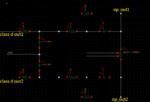c75739
Newbie level 2
I want to filter output of my full-bridge class d power amp. I'm trying to connect an ideal differential op to class d output for simulation. But class d output through ideal differential op , growing noise floor(5~10dB). I suspect that problem is incorrect op/filter connection. (pic. A)

pic.A
First, I'm mapping circuit(pic. A) to spectre(use one VCVS(pic. B) or two VCVS(pic. C)). I'm trying 2 connections below:

pic. B one VCVS class d output SNDR is 96dB, op(ideal, gain: 100000) out is 82 dB problem is that op is ideal, 96dB to 82dB doesn't make sense.

pic. C two VCVS class d output SNDR is 96dB, op(ideal, gain: 100000) out is 74 dB problem is that op is ideal, 96dB to 74dB doesn't make sense.
I think SNDR of ideal differential op output, sholdn't decrease much.
Does the connection of op(pic.B or pic.C) is correct? Any suggestion?
Thankyou!!!!

pic.A
First, I'm mapping circuit(pic. A) to spectre(use one VCVS(pic. B) or two VCVS(pic. C)). I'm trying 2 connections below:

pic. B one VCVS class d output SNDR is 96dB, op(ideal, gain: 100000) out is 82 dB problem is that op is ideal, 96dB to 82dB doesn't make sense.

pic. C two VCVS class d output SNDR is 96dB, op(ideal, gain: 100000) out is 74 dB problem is that op is ideal, 96dB to 74dB doesn't make sense.
I think SNDR of ideal differential op output, sholdn't decrease much.
Does the connection of op(pic.B or pic.C) is correct? Any suggestion?
Thankyou!!!!